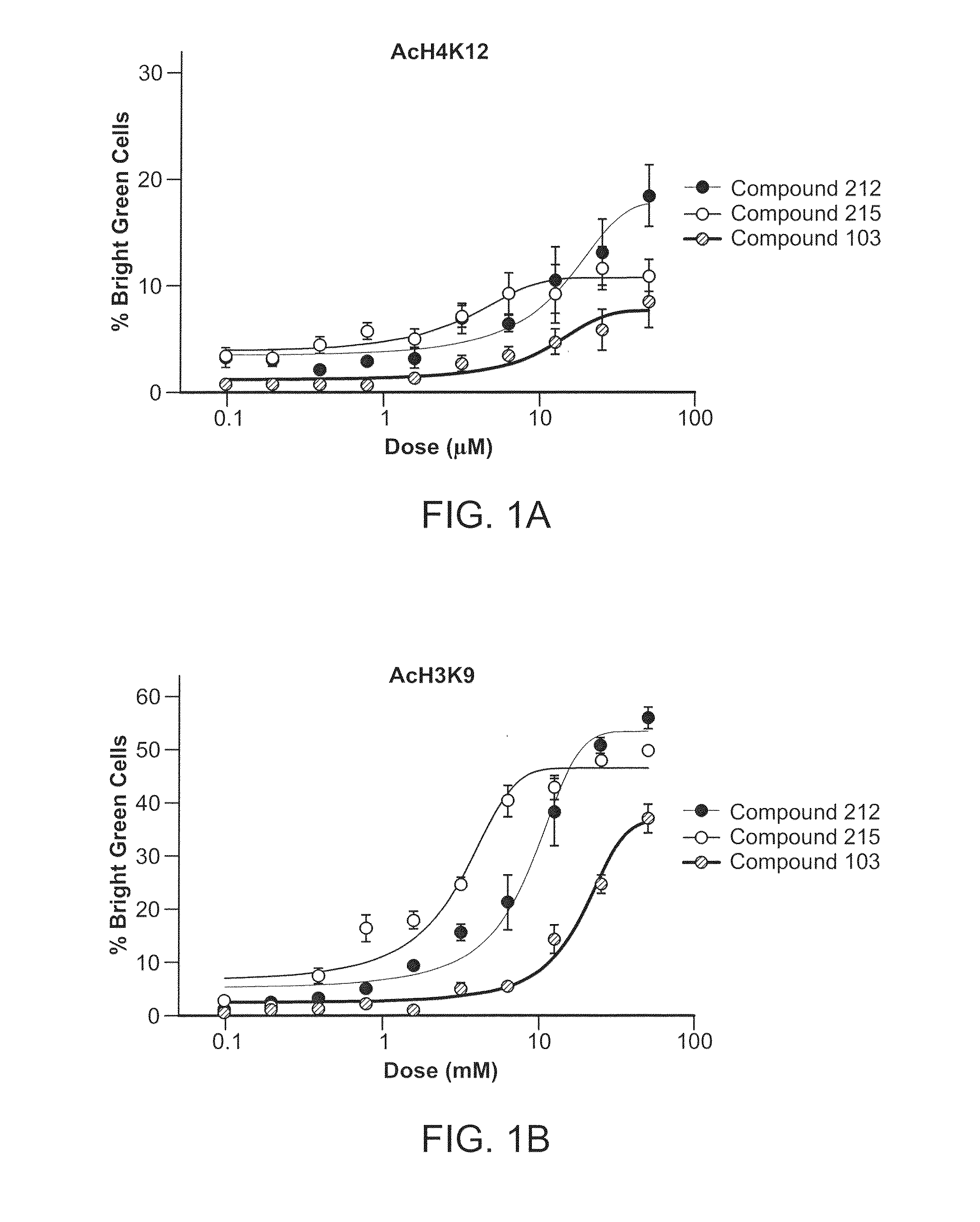Inhibitors of Histone Deacetylase
a technology of histone deacetylase and inhibitors, which is applied in the direction of anti-infective drugs, amide active ingredients, drug compositions, etc., can solve the problems of complex problems and the inability to identify selective inhibitors, and achieve the effects of increasing synaptic plasticity, increasing synaptic density, and increasing dendritic density in neurons
- Summary
- Abstract
- Description
- Claims
- Application Information
AI Technical Summary
Benefits of technology
Problems solved by technology
Method used
Image
Examples
example 1
Preparation of Compounds of the Invention
[0289]
Synthesis of N-(2-amino-5-(thiophen-2-yl)phenyl)tetrahydro-2H-pyran-4-carboxamide (45)
[0290]
[0291]To a solution of 4-bromo-2-nitroaniline (1, 10.0 g, 46.1 mmol, 1.0 eq.) in DMF (50 mL) at 0° C. was added sodium hydride (1.8 g, 73.7 mmol, 1.6 eq.) slowly. After 30 minutes, a solution of di-tert-butyl dicarbonate (12.1 g, 55.3 mmol, 1.2 eq.) in DMF (50 mL) was added dropwise. The reaction mixture was then stirred for 16 h at room temperature. The reaction was quenched with water. The product was extracted with methyl tertiary butyl ether. The organic layer was washed with water and brine. The combined organic layers were dried over anhydrous sodium sulfate, filtered and concentrated in vacuo. The product was purified by column chromatography (silica gel, 0-20% EtOAc / hexanes) to give tert-butyl (4-bromo-2-nitrophenyl)carbamate (7.5 g, 51% yield) as yellow solid.
[0292]A mixture of tert-butyl (4-bromo-2-nitrophenyl)carbamate (6.0 g, 18.92 mm...
example 2
[0384]
Synthesis of propyl azetidin-3-ylmethyl (2-amino-5-(thiophen-2-yl)phenyl)carbamate (75)
[0385]
[0386]To a stirred solution of 5-bromo-2-nitroaniline (10.3 g, 47.3 mmol, 1 eq.), thiophen-2-ylboronic acid (9.08 g, 70.9 mmol, 1.5 eq.) and tetrakis(triphenylphosphine)palladium(0) (5.46 g, 4.73 mmol, 0.1 eq.) in THF (150 mL) was added a solution of sodium carbonate (7.27 g, 68.6 mmol, 1.45 eq.) in water (15 mL). The resulting mixture was warmed to 90° C. for 18 h. The reaction was then diluted with EtOAc and water and filtered through Celite. The organic layer was separated and dried over sodium sulfate, filtered and concentrated under reduced pressure. The crude product was purified by column chromatography (silica gel, 2% EtOAc / hexanes) to afford 2-nitro-5-(thiophen-2-yl)aniline (12.0 g, 79% yield).
[0387]To a solution of 2-nitro-5-(thiophen-2-yl)aniline (0.30 g, 1.36 mmol, 1 eq.) and triphosgene (0.24 g, 0.82 mmol, 0.6 eq.) in dichloromethane (7 mL) at 0° C. was added TEA (0.38 mL,...
example 3
Inhibition of Histone Deacetylase Enzymatic Activity
[0593]The following trypsin-coupled protocol and Caliper protocol described herein was used to assay the compounds of the invention.
Trypsin Coupled Assay:
HDAC1-KineticIC50-3 Hr PreIncubation
Working Stocks
[0594]1×HDAC Assay Buffer:[0595]50 mM HEPES(GIBCO 15630-114), 100 mM KCl, 0.001% Tween-20(Zymed 00-3005), 0.05% BSA(Invitrogen, P2489), pH 7.4[0596]1.5×HDAC+1.5× Trypsin: 225 nM Trypsin(Worthinton)+0.18 μg / ml HDAC1(BPS Inc) in assay buffer[0597]300× Trypsin stock is made up in HDAC Assay Buffer, aliquoted and stored at −80° C.[0598]3× Substrate: 18 μM Substrate in assay buffer[0599]BPS Enzyme and Substrate amounts (per well)
HDACclassEnz amount[Substrate] (μM)SubstrateHDAC1Ia3.5 ng*6*1600*
Protocol (Costar 3573 384-Well Plate—Black / Black Bottom)
[0600]Assay is performed at room temp. reagents are stored on ice
1) Add 20 μl of enzyme+trypsin in assay buffer (Combi)
2) Pin transfer compounds (100 nl pins)
3) incubate 3 hours at room temp
4)...
PUM
| Property | Measurement | Unit |
|---|---|---|
| Density | aaaaa | aaaaa |
| Plasticity | aaaaa | aaaaa |
Abstract
Description
Claims
Application Information
 Login to View More
Login to View More - R&D
- Intellectual Property
- Life Sciences
- Materials
- Tech Scout
- Unparalleled Data Quality
- Higher Quality Content
- 60% Fewer Hallucinations
Browse by: Latest US Patents, China's latest patents, Technical Efficacy Thesaurus, Application Domain, Technology Topic, Popular Technical Reports.
© 2025 PatSnap. All rights reserved.Legal|Privacy policy|Modern Slavery Act Transparency Statement|Sitemap|About US| Contact US: help@patsnap.com



